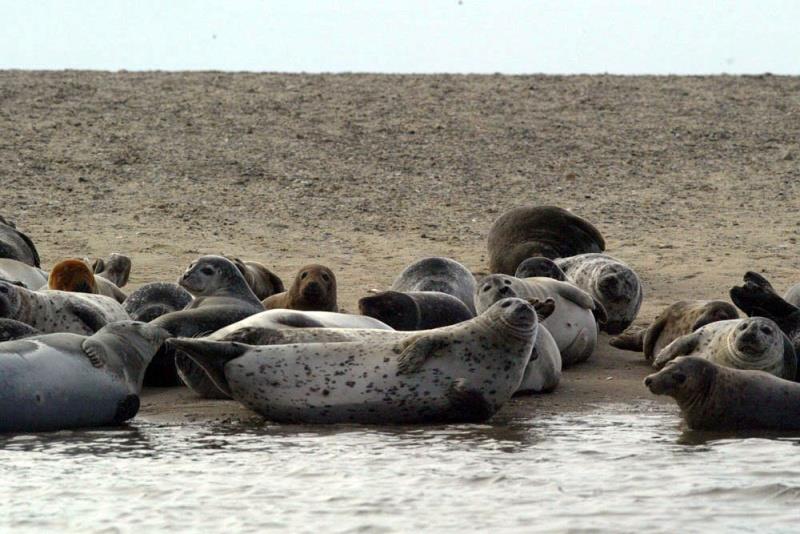
Top 10 facts about sharks and seals
by NOAA Fisheries 10 Aug 2019 12:04 UTC

Gray and harbor seals hauled out on the beach at Jeremy Point in Wellfleet, Massachusetts in 2007 © NOAA Fisheries
Seals and sharks: A few things in common
- Both seals and sharks have inhabited waters around Cape Cod and the Islands for centuries, long before humans.
- Both have been increasing in numbers since the passage of federal regulations after populations were severely depleted by hunting and fishing.
- Seals and sharks each play a role in maintaining a healthy oceanic ecosystem.
- Population numbers for both seals and sharks in Cape waters are unknown due to their seasonal migrations and foraging behaviors.
- Both have diverse diets and eat what is readily available. Seals and sharks each consume different prey based upon their age, size and location.
Seals
There are two similar species of seals that inhabit the Cape and Islands - gray and harbor seals. Adult gray seals can weigh between 550 and 850 pounds and are on the Cape year-round. Adult harbor seals weighing between 100 and 300 pounds are seasonal residents on the Cape between September and May.
Gray seals: There are an estimated 425,000 gray seals (2016 study) that move up and down the Atlantic coast between the U.S. and Canada, where their abundance is increasing at a rate of 4-5% per year. During the breeding season, December through February, there are an estimated 27,000 in U.S. waters. Gray seals eat primarily sand lance, hakes and flatfish, and squids. Diet data comes mainly from juvenile animals; more research is needed on animals at other life stages.
Harbor seals: There are an estimated 75,000 harbor seals from eastern Canada to North Carolina. Their breeding season is May through June, primarily in Maine. After the breeding season ends they disperse throughout the Northeast and Mid-Atlantic region. In the Northeast region, they eat mainly a variety of groundfish (hakes, cod, haddock, flatfish), redfish, herring and squids; diet data comes mainly from juvenile animals and more research is needed on animals at other life stages.
Seals move around to forage and spend significant amounts of time in the water, making it hard to estimate their numbers. Seasonal changes in gray and harbor seal abundance outside of the breeding season are unknown. Population numbers have been increasing since federal regulations protecting marine mammals were put in place in the 1970s. A 2016 study estimated 30-50,000 animals at various times in southeastern Massachusetts.
Culling has been tried in the past (U.S. and elsewhere) and was shown to be ineffective. Gray seals from Canada continuously supplement seals in the U.S., so seals that are removed will just be replaced by animals from other regions.
Sharks
Shark populations have been slowly increasing since the 1990s due to the implementation of management measures. The U.S. has managed its shark fisheries since 1993, and banned both the commercial and recreational harvesting of white sharks in 1997. There is currently no estimate of white sharks in Cape waters; research is ongoing.
A 2014 study used records compiled over more than 200 years, revealing that white sharks occur primarily between Massachusetts and New Jersey during the summer, off Florida during winter, and have a broad distribution along the U.S. East Coast during spring and fall. White sharks appear to be more common in coastal rather than offshore waters in the U.S. Atlantic, although preliminary satellite tracking data suggest individuals may also spend considerable time beyond the continental shelf.
Most sharks are opportunistic feeders, but some species have a more selective diet. The basking shark, often mistaken for a white shark in New England waters, is one of the largest species and is a filter feeder. The smooth dogfish, a summer visitor to New England waters, is a small coastal shark that specializes in crustaceans. Many species, like the white shark, change their diet as they get larger, eating smaller prey items when they are young and moving on to larger prey as they grow.
The white shark eats primarily fish when it is young and prefers marine mammals at larger sizes. Scavenging is also an important source of food for many sharks. White sharks are fairly solitary animals, but have been known to feed together in groups when they are scavenging a large food source, such as a dead whale.
Four million people visit the Cape Cod National Seashore each year. As the human population increases, more people are visiting beaches. The 2018 fatal shark attack on the Cape was the first in Massachusetts in more than 80 years (last was 1936 in Mattapoisett). A shark attack occurs once every 730 million beach visits, or about one in a billion chance (Stanford University study).
Worldwide, sharks kill on average six humans each year; in the U.S. an average of one person per year. Humans kill an estimated 100 million sharks each year. States with the highest number of shark attacks since 2000 (in order from highest) are Florida, Hawaii, South Carolina, California, North Carolina, Texas, Oregon, Georgia and Alabama. In 2018 there were 32 unprovoked shark attacks in the U.S., with one fatality. (Source: International Shark Attack File)
Over a period of five years, at just six beaches at the Cape Cod National Seashore, lifeguards rescued 680 people from the water due to riptides. On the Outer Cape, the risk of drowning from rip tides is much greater than the risk of being attacked by a shark. Odds of being injured by sharks are far less than from fireworks, lightning strikes, car and bicycle accidents, and jellyfish stings.
Bees, wasps, snakes, dogs, and taking selfies cause far more fatalities each year than sharks. On the list of dangers in aquatic environments, sharks rank near the bottom. Odds of drowning and other beach-related fatalities are 1 in 2 million, shark attacks are one in 11.5 million.
For more information, please contact Shelley Dawicki.